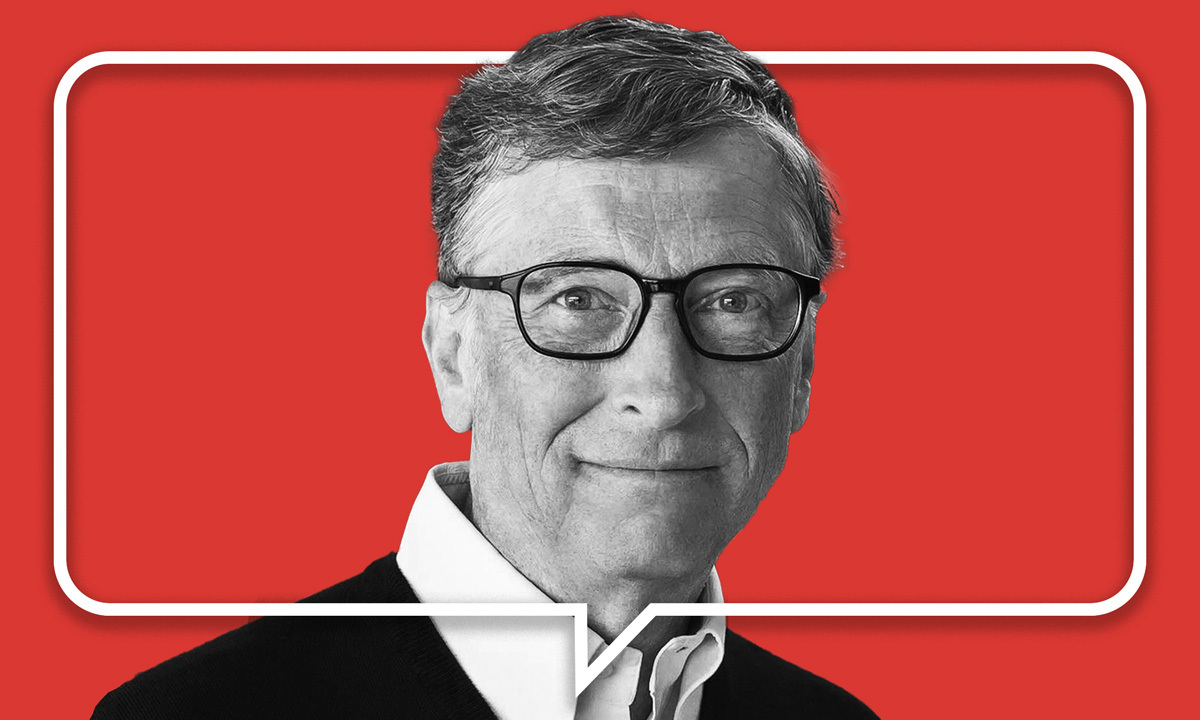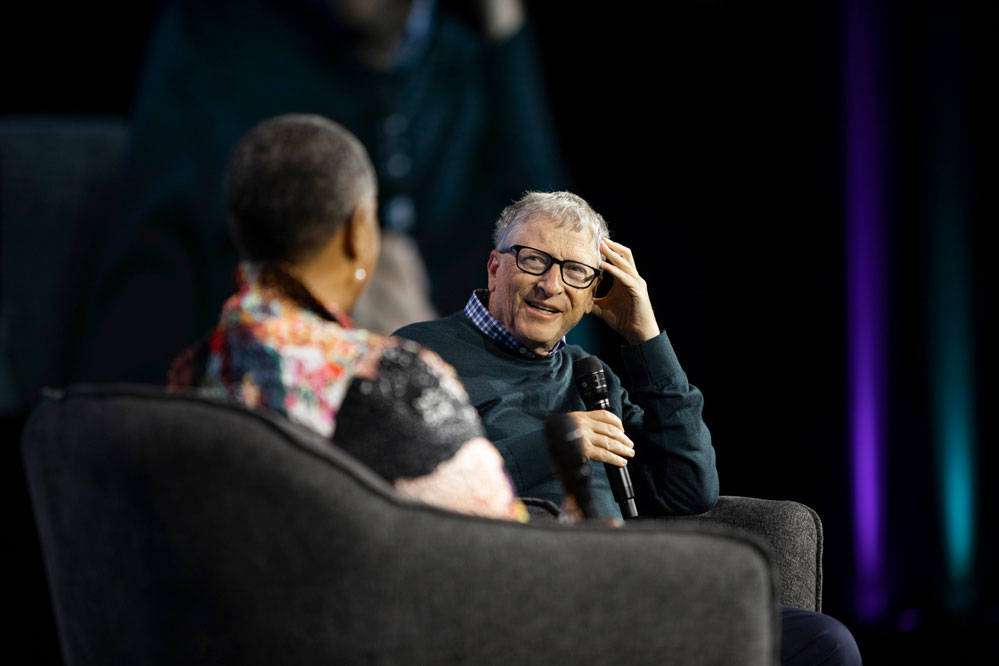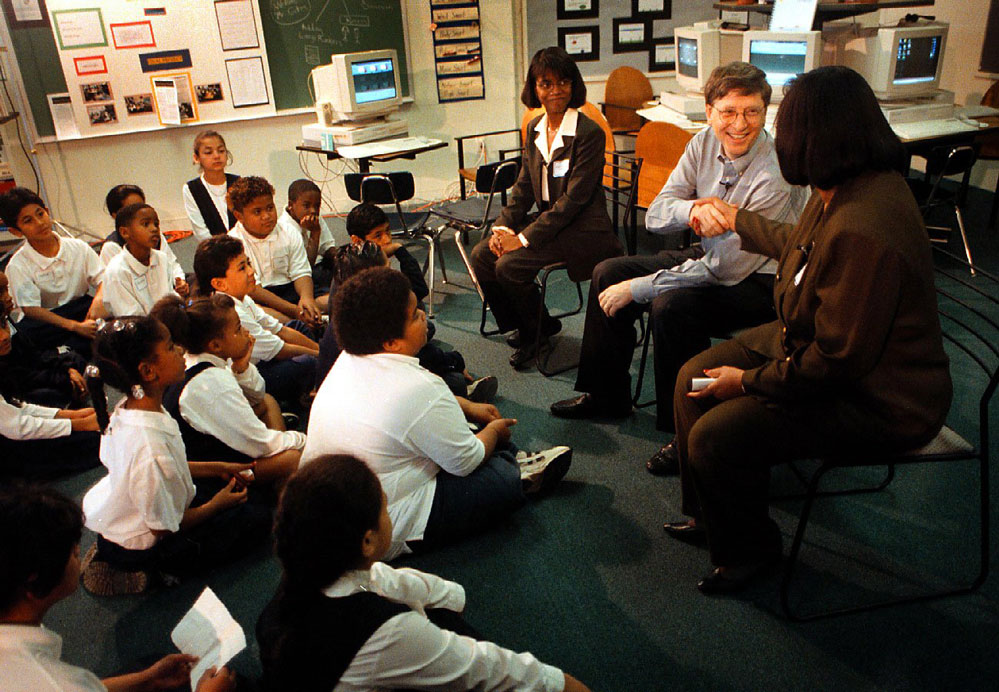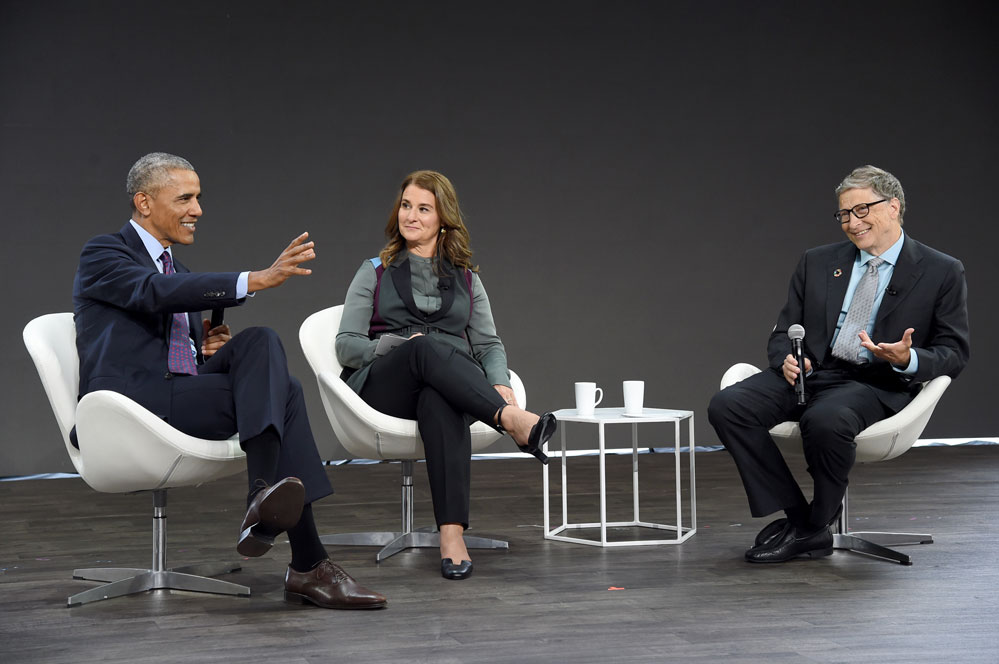‘U.S. Education Is a Challenged Space’: In Exclusive 74 Interview, Bill Gates Talks Learning Recovery, AI and His Big Bet on Math
The Microsoft founder is pushing in all his chips on an effort to revive math learning

Get stories like these delivered straight to your inbox. Sign up for The 74 Newsletter
Bill Gates wants Americans to stop hating math.
Our struggles teaching the subject — whether evidenced by our middling performance against peer nations or the striking “math anxiety” reported even by young children — are a stumbling block preventing kids from reaching their goals, he has argued. And the obstacle has only grown since the generational setback of COVID-19, which triggered the greatest learning crisis in history. Scores on the latest iteration of the National Assessment of Educational Progress sank to levels last seen in the early 2000s.
That’s part of the reason why the Bill & Melinda Gates Foundation announced last fall that it would make math “the cornerstone of our K–12 education program strategy” over the next decade. Powered by $1.1 billion in new investments, the philanthropic giant will work with its partners to devise better curricular materials, improve teacher training and professional development, and fund research and development breakthroughs that hold the potential to transform the classroom experience.
The agenda partially reflects Gates’s personal fascination with mathematics, which dates back to his years as a student. Before embarking on perhaps the most consequential career in the history of software, the future Microsoft founder blazed through Harvard’s legendarily rigorous Math 55 sequence, only focusing exclusively on computer science because he considered it unlikely that he would become one of the world’s greatest mathematicians. Distinguishing himself even in the rare air of tech founders, he co-authored a paper that settled the delicious-sounding question of “pancake sorting” for decades.
In a broader sense, the huge bet on math also builds on the Foundation’s existing work in the K–12 sphere. Gates has proven one of the most influential actors in American education over the first part of this century, fostering a movement toward small schools and promoting the adoption of the Common Core State Standards. Even when some efforts didn’t bear fruit — such as a failed seven-year campaign to strengthen teacher evaluation — Gates’s deep pockets and commitment to experimentation have helped make the weather in education policy for the last two decades.

Other priorities are expected to take a backseat through 2026, while math programming will grow from 40 percent of the organization’s education budget to 100 percent. It’s a commitment that dovetails with the public’s own concerns, Gates says: According to a poll released this week by the Foundation, large majorities of adults believe that math instruction needs an overhaul to become more relevant and engaging.
In a discussion with The 74’s Kevin Mahnken at the 2023 ASU+GSV summit — an educational technology conference that draws thousands of educators, investors, and entrepreneurs annually — Gates talked about America’s post-pandemic math deficits and what it will take to climb out of them. He also touched on the potential rewards to helping kids overcome their anxiety and fall in love with math.
“There is a gigantic upside in improving our public education system, both economically and in terms of equity,” Gates said. “But the country’s not falling apart as much as you might think.”
This conversation has been edited for length and clarity.
The 74: What is the extent of the math learning crisis that’s followed COVID? And can it be compared to the aftermath of other society-level emergencies, like the financial crisis of 2007?
Bill Gates: Even pre-pandemic, what the U.S. had was very disappointing. Math is a basic skill for many areas, and your attitude and success with regard to math is very predictive of whether you graduate high school or go on to higher education.
In our K–12 strategy, the Gates Foundation has shifted to math as our biggest priority by quite a bit. It’s a decision we made around the year before the pandemic started. It’s fair to say that the pandemic worsened math scores more than any other scores. Math is kind of a specialized skill in that your exposure can drop to near zero if you’re out of school, whereas your exposure to reading — and maybe, to some degree, writing — may not drop as dramatically. So it’s not that surprising, and we also see that math decay over the summer is dramatically higher than reading decay and writing decay.
You’ve got this huge loss, but there are some viewpoints that we’re starting to see some meaningful rebound. There was an article in the New York Times on that a few months ago. Then again, because our progress in math over the last 20 years has been so modest, the scores have hardly gone up at all. They’ve gone up a little bit. I’m only saying this to note, okay, we’re back where we were 10 years ago. But that’s partly a statement about the size of the loss, and it’s partly a statement about the very, very slow nature of the gains that we’ve had in math. The U.S. is doing quite poorly compared to other rich countries, even though the amount we spend on it is higher than any other, by substantial amounts.
The losses are tragic, though there are different ways of looking at them in terms of how much is in the inner city and inequitable. Some reports show learning loss as pretty much across-the-board; others show it much more in their inner city. If you abstract out how long your classroom was closed or what degree of online access you had, that is pretty predictive of lower performance.
And sadly, that does correlate with the lower income, minority-serving schools being worse off because their ability to do online learning, to get internet access, to get a device — almost every element that has to come together for good online learning — is less present in an inner-city public school than, to take the extreme, a suburban private school. And in the U.S., we had our schools closed longer than any other country.
What are the big-picture costs of poor math learning on America’s competitiveness as both an economic and a geopolitical force?
The shortcomings of the U.S. education system are clear in terms of the inequity you end up with: the kind of jobs, salaries, mobility you’d like to see in society. Education is the great enabler of mobility, and we’re falling short on that. In fact, the U.S. economy has done relatively well because there are so many factors that enter into it, including the ability of the U.S. to draw very talented people from the entire world. But I think the predictions that this is going to hurt us in the long run are true, and we’d be further ahead if we were running our education system as well as we’d like to.
“We will not have remedied our NAEP deficit — even to get back to where we were before the pandemic, which wasn’t an ideal situation — during the time that the ESSER money is still available. You also have shrinking school districts in many places, and scaling down while maintaining quality can be a very difficult thing. So U.S. education is a challenged space.”
This is why the Gates Foundation basically has two big things we do. The global work, which is centered on health and some things related to health, is the biggest thing for us because the vacuum of resources and thinking for malaria and childhood death was mind-blowing. In some of those areas, the Foundation is almost alone.
Research and philanthropy related to education should be a lot larger than it is, but we’re not alone there. There are a lot of players, and by some measures we’re one of the biggest players. There is a gigantic upside in improving our public education system, both economically and in terms of equity. But the country’s not falling apart as much as you might think. We make up for it by having universities that are the strongest in the world, and we do get some intellectual capacity because we’re an attractive place. Almost no other country in the world has this: When people say, “Hey, China’s strong,” they’re not saying that all great scholars in the world are flocking to China or India or Japan. Other than a few other English-speaking countries, the U.S. is truly unique in that respect.
It sounds like you’re saying that America isn’t so much falling behind the rest of the world as it is falling behind its own potential. That reminds me of research from Harvard’s Tom Kane, which found that we could lose almost a trillion dollars in future wages if eighth-grade math deficits aren’t significantly mitigated.
We’re going to be paying a price for a long time in areas that are hard to measure. We’ve seen this in terms of mental health problems, which obviously interact with young people’s persistence in education. The isolation that came out of the pandemic was a huge setback. How you map that onto economic figures — okay, there are a lot of assumptions in those numbers — but we’ve got a lot of making up to do.
And most of the resources that help with that make-up are only going to be around for a couple of years. We will not have remedied our NAEP deficit — even to get back to where we were before the pandemic, which wasn’t an ideal situation — during the time that the ESSER money is still available. You also have shrinking school districts in many places, and scaling down while maintaining quality can be a very difficult thing. So U.S. education is a challenged space.
Switching gears a bit, you’ve previously compared the emergence of ChatGPT with the development of the microprocessor. I’m wondering how you contextualize it alongside other civilizational breakthroughs, like the Green Revolution or the emergence of vaccines.
The Holy Grail of computer science from the first time anybody did computation was how its abilities could compare with human capabilities. The so-called Turing Test was formulated before I was born, and throughout my history of using computers, there were things like Shakey the Robot or obscure things like ELIZA, which sort of tried to be a dialogue machine. Almost everybody who starts writing programs will do some random sentence generator where you have various grammatical patterns and sets of words and generate blather. It’s funny because sometimes it almost seems to make sense.

We’ve been making progress in human sensory things, like matching visual recognition and speech recognition of humans. When I worked on AI stuff in the ‘70s and ‘80s, we weren’t making that much progress, but then there was the combination of scaling and new techniques — so-called machine learning techniques. It didn’t bother people that much that it could listen better than us or that, in a sense, it could see better than us, but there was no ability to read or write.
What we’ve got now is pretty amazing. It’s got huge limitations in terms of its accuracy and how you can train it. But given the scale of the industry and the promise — the amount of activity and the pace of innovation to take the current limitations and make it more effective — it’s pretty mind-blowing.
“The progress on public health is really unbelievably dramatic… There’s no equivalent in education. The equivalent would have been if the dropout rate from high schools was cut in half, that the dropout rate from college was cut in half, that U.S. math scores went up 30 percent, that we’re at the top of the lead tables. No such miracle took place.”
Its reading and writing capability has got everyone saying, “Wow.” When you sit at the computer creating models or taking a document or making a presentation, its ability to help you be more productive on those things is really phenomenal. And we’ve gone from no ability to do that to a pretty substantial ability just in this calendar year.
You mentioned your twin interests of public health and public education. Do you think the Gates Foundation’s successes in the former sphere — perhaps measured in the huge decline of malaria deaths in this century — are greater than those in the latter? And if so, why might that be?
The progress on public health, because it was so ignored, is really unbelievably dramatic. I’m not sure most people are aware of it, but if you gave a report card to humanity of what we’ve done well since the year 2000, at the top of that report card would be reducing the number of children who die under the age of five from over 10 million to under 5 million. Now, most of those deaths were in poor countries, and so the visibility to most Americans of that miracle is extremely low even though some American government aid was part of that; certainly, mass amounts of government science were part of that. And our Foundation played a fairly central role, if not a solo role. We have a lot of partners, including the U.S. government.

There’s no equivalent in education. The equivalent would have been if the dropout rate from high schools was cut in half, that the dropout rate from college was cut in half, that U.S. math scores went up 30 percent, that we’re at the top of the lead tables.
No such miracle took place.
With education, you do have trends that are tough. Very appropriately, the labor market gives capable women way more opportunities than it did in the past. But the education system cheated somewhat by having very talented women who weren’t given the opportunities they should have. So you have a little bit of adjustment in your teaching pool. And given where you have population growth, the average incomes of the kids going into the public school system is a bit lower, with more non-English-speaking households. That’s a little bit of a negative factor, but we’ve maintained and improved slightly. We’ve improved math scores slightly, racial equity slightly, high school graduation rates slightly.
It’s interesting. You can come to a conference like this or visit a really exemplary school and be reminded, “Wow, there are outliers!” There are microcosms where things are pretty fantastic, even at the school level. Certainly at the classroom level, you’ve always been able to go find the Stand and Deliver-style, unbelievable teacher. And whenever you find variance, you can say to yourself, “Hey, how come we can’t capture that best practice and get the average teacher to be close to that top teacher? What is it about training and understanding and incentives that makes that very difficult?”
We haven’t succeeded as much on that as we’d like. We have all this technology where, yes, you can look up YouTube videos and Wikipedia articles and sit there and do math questions for free on Khan Academy. And yet none of that — none of the seriousness about transferring best practices in terms of traditional teaching, and none of the new technology — has come in and really made that dramatic of a difference. Somebody could say, “Well, give up,” but not many people want to do that. We’re stubborn enough to believe that the improvements that have been made were worthwhile even though, compared on a per-dollar basis to what we’ve done in global health, it’s just not the same thing.
“If I said to you that the best math teacher was somebody 50 years ago, you could actually believe that. If somebody said that the best cancer doctor was some guy 50 years ago, you’d go, ‘What the hell are you talking about? That’s the silliest thing I’ve ever heard.’ “
We save lives for $1,000 per life. And in education, [laughs] we haven’t done the equivalent of saving a life for $1,000. We feel like our work has been good, including helping the field find dead ends. In education, the R&D investment about “Why is that teacher good” or “Why should you insist on homework being done?” is way less than what it should be. And our foundation is one of many that’s tried to bring more understanding to what works and what doesn’t.
You probably saw the proposal to dramatically increase the reach of the Institute for Education Sciences and establish something like a “DARPA for education,” with the aim of accelerating the development of breakthrough technologies for learning. It seems like there might be a bigger role for the federal government to play in this field.
For all governments, all over the world; a lot of what we learn about education is pretty universal. But anyway, as a percentage of its size in the economy and the benefit of improving it, you could say there’s pretty dramatic underinvestment in K–12 research because the numbers are actually quite small. And if I said to you that the best math teacher was somebody 50 years ago, you could actually believe that. If somebody said that the best cancer doctor was some guy 50 years ago, you’d go, “What the hell are you talking about? That’s the silliest thing I’ve ever heard.”
So the field has changed and improved, but pretty modestly. Helping those researchers — that’s still worth investing in. I was at a middle school this morning called Chula Vista where — together with a partner, High Tech High — we do some of our math instruction work. When you get into the classroom, it’s fascinating to see what works and what doesn’t. I have to say, when you see the teachers who are really engaged in trying to help other teachers do better, it often reminds you why this is an important field and that there really is promise.
When I think about the big K–12 reforms that were launched the last few decades by both Washington and institutions like the Gates Foundation, it seems like there’s now much less political will to pursue huge projects like those. I’m wondering if you are at all worried that really ambitious ventures — you could also include vaccine development and advocacy — are going to be a little harder to launch, harder to support.
Hmm. I’d say that, both under Bush and Obama, there was a real effort at the federal level to drive change in education. Of course, the federal level has the advantage that it affects all 50 states. It also has the disadvantage that you’re writing some rule about, “Please spend the money on this thing” in Washington, D.C., and then have many layers and diverse environments in the states.

For better or for worse, the amount of experimentation and top-down system reform that’s going to come from the federal government after the Obama period will be very modest. You can say that’s good or bad, but it’s just a fact that Democrats and Republicans in Congress are not thinking, “We’re going to change the way education is done.” The action has moved, you could say, to the state, district or classroom level, or these ed tech people, or the things that philanthropists fund.
There isn’t one common theme. Charter schools continue to advance, although they’re a modest percentage of all students. Interestingly, there’s a huge shift such that charter schools are growing more in red states than blue states now. It’s complicated to characterize the results, but they’re largely good, and they are laboratories of learning. A lot of good ideas that should suffuse themselves into the broader public system come out of that charter experience.
I don’t think it’s that people are satisfied with our current education system. We did a survey about math recently where parents were very willing to say, “Hey, instruction should be different to drive the relevance and the engagement,” so there’s still open-mindedness that education can be better. Hopefully it’s not too politicized in that, if you show that a curriculum can get better results, people view that as helping kids and helping society.
I’m sure that if you get into some political topics in the curriculum, you may run into some sort of deadlock. But most educational things can stay away from those issues. The way we teach multiplication or algebra, we can do far better. That’s certainly a belief embedded in the priority we’re putting into math and math curriculum.
A lot of our readers might not be aware that you considered becoming an academic mathematician yourself. Are you still drawn to math?
Yes! Math is fascinating. The way these new AI models work is extremely mathematical. If you learn all this new stuff, you’re drawing more on your math skills than your coding skills.
I initially did math, I was very good at math, and that helped me do coding. My framework for the world is very mathematical. And the boundaries of math have not moved all that much: We’ve proved the Four-Color Theorem, we’ve proved Fermat’s last theorem. It’s fun to track where we’re making progress and where we’re not. But I enjoy math, and thank goodness, because otherwise I couldn’t be as engaged in the AI stuff as I am.
Even when I’m doing my global health work, or when we’re looking at the trends in these education developments, math is important. I like symbolic, complex math, but just data science — which we’re hoping to get into the curriculum and make the curriculum more interesting — that stuff is amazing now.
See previous 74 Interviews: Sal Khan on COVID’s math toll; economist Tom Kane on the challenge of reversing learning loss; and education researcher Martin West on last fall’s NAEP results. The full archive is here.
Disclosure: The Bill & Melinda Gates Foundation provides financial support to The 74.
Get stories like these delivered straight to your inbox. Sign up for The 74 Newsletter


